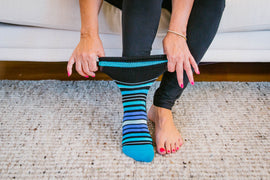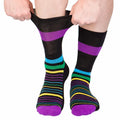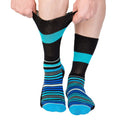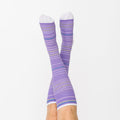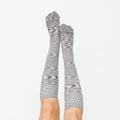Can Diabetics Eat Bread?
Posted by SIMON LIM

When you have diabetes, one of the most common questions you get asked is, "What can't you eat?" The list of foods that are off-limits for diabetics seems to be ever-growing and can be confusing. So, today we're going to tackle a common food that diabetics often ask about - bread.
There are many misconceptions about bread and diabetes, so let's set the record straight. Can diabetics eat bread? In this blog post, we'll discuss whether people with diabetes can eat bread safely and what types of bread are best for them.
Bread and Diabetes - What's the Connection?
Before we jump into whether or not diabetics can eat bread, let's first understand the connection between bread and diabetes. Carbohydrates are turned into sugar (glucose) in our bodies. We all know that too much sugar can lead to high blood glucose levels. When blood glucose levels are high, it can damage your nerves and blood vessels. This can lead to complications like heart and kidney problems.
Every slice of bread has about 15 grams of carbohydrates. This is already equal to the recommended carbohydrate intake per serving. And most people eat more than one slice of bread at a time! That's why people with diabetes need to be aware of how many carbohydrate servings they eat throughout the day. If you eat more carbohydrates than your body can handle, your blood sugar levels will rise.
So now that we understand the connection between bread and diabetes, let's answer the question on everyone's mind: can diabetics eat bread?
Can Diabetics Eat Bread?
The short answer is yes, but it depends on the type of bread and how much you're eating. For example, white bread is made with refined flour, which breaks down quickly into sugar. On the other hand, whole wheat bread is made with unrefined flour. Unrefined flour doesn't break down as quickly into sugar. If you have diabetes, opting for whole wheat bread is essential. Whole bread won't cause your blood sugar levels to spike as quickly as white bread will.
It would also be best to watch how much bread you're eating. Remember that one slice of bread equals one carbohydrate serving. So if you're planning on eating two slices of toast for breakfast, you'll need to account for those two carbohydrate servings at breakfast time. The best way to do this is by using a food diary or tracking app to ensure you stay within your bread budget for the day.

Healthy Bread Options for Diabetics
If you have diabetes, you may wonder what kind of bread is best for you. The good news is that there are various options available. With a little research, you can find the perfect type of bread for your individual needs.
- Whole Wheat Bread
Whole wheat bread is made from flour that includes all three parts of the wheat kernel—the germ, bran, and endosperm. It has more fiber than white bread, which is made from just the endosperm. Because of its high fiber content, whole wheat bread can help to regulate blood sugar levels. It can also prevent spikes after meals. Additionally, whole wheat bread is a good source of vitamins and minerals such as iron, folate, and magnesium.
- Multigrain Bread
Multigrain bread is made from various grains—usually wheat, rye, oats, corn, and rice. Like whole wheat bread, multigrain bread contains more fiber than white bread. This can help to regulate blood sugar levels. Multigrain bread also has a lower glycemic index than white bread. This means it won't cause your blood sugar to rise quickly after eating. Multigrain bread is also a good source of B vitamins and other essential nutrients.
- Sourdough Bread
Sourdough bread is made from a fermented dough containing yeast or lactobacilli bacteria. This fermentation process helps break down the dough's carbohydrates into simpler sugars. The process makes them easier to digest. Sourdough bread also has a lower glycemic index than white bread. One study even found that sourdough bread may help to reduce inflammation in people with diabetes.
Breads To Avoid
- White Bread
White bread is made from flour stripped of all its nutrients. It is then bleached with chlorine gas or benzoyl peroxide. This bleaching process gives white bread its signature light color. However, it also makes the carbohydrates in white bread more quickly absorbed by your body, which can cause a spike in your blood sugar levels. If you are going to eat white bread, pair it with protein-rich food like peanut butter or cheese. This will help to slow down the absorption of carbs.
- Fruit Bread
Fruit bread might sound healthy, but it is loaded with sugar. One slice of fruit bread can have up to 12 grams of sugar! Most of this sugar comes from high fructose corn syrup, used to sweeten the fruit added to the bread. Try whole-grain bread with a few fresh fruits per slice for a healthier alternative.
- Refined Flour Bread
Bread made with refined flour has been milled to remove the outer layer of the wheat grain (the bran) and the wheat germ. This leaves only the starchy endosperm, which has very little nutritional value. Refined flour bread will cause blood sugar levels to spike and crash soon after. This is because there is nothing in the flour to slow down carbohydrate absorption rates.

How to Pick a Healthy Bread for Diabetics
When you have diabetes, one of the most important things you can do is ensure you eat a healthy diet. That means paying close attention to the foods you eat, including bread. But with all the different types of bread on the market, how do you know which one is the best for your health?
Here's a quick guide on how to pick healthy bread for diabetics. The most important thing to look for is the nutrition label. Here are a few things to keep in mind when you're reading nutrition labels on bread:
- Look at the serving size. This will tell you how much bread you should eat in one sitting.
- Check the calories per serving. You want to ensure that the bread you're eating will not add too many calories to your diet.
- Look at the carbohydrates. Breads can vary widely in their carbohydrate content, so choosing a bread that fits your daily carb intake is essential.
- Check the fiber content. Fiber is an important nutrient for diabetics, and you want to ensure that your bread has enough fiber to help keep your blood sugar levels in check.
- Unsalted or low-sodium options. Try to find an unsalted or low-sodium option. Too much sodium can increase blood pressure, which people with diabetes need to be careful of.
Takeaways
So can diabetics eat bread? Well, it kind of depends.
Bread is tricky for people with diabetes because all carbs turn into sugar in our bodies. However, the key is to monitor portion sizes and choose whole grain varieties whenever possible. There are also many brands of sugar-free bread on the market that are safe for diabetics to eat. As always, we recommend checking with your doctor before making any changes to your diet.
SHARE:




